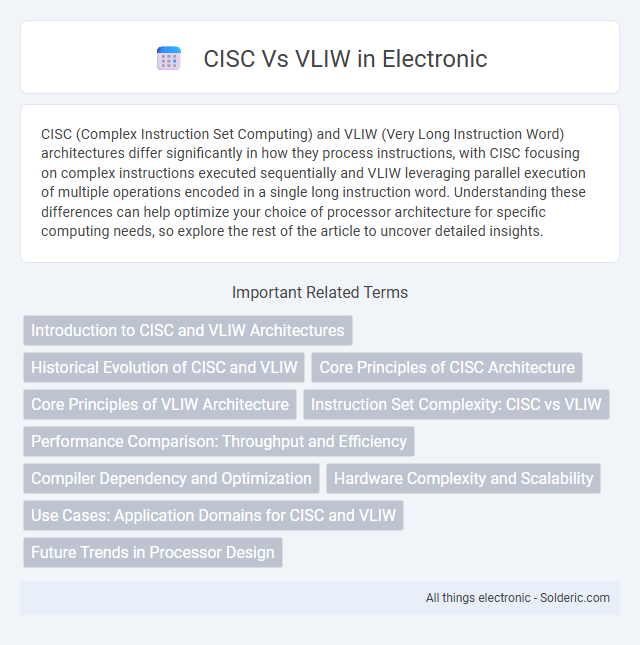CISC (Complex Instruction Set Computing) and VLIW (Very Long Instruction Word) architectures differ significantly in how they process instructions, with CISC focusing on complex instructions executed sequentially and VLIW leveraging parallel execution of multiple operations encoded in a single long instruction word. Understanding these differences can help optimize your choice of processor architecture for specific computing needs, so explore the rest of the article to uncover detailed insights.
Comparison Table
| Aspect | CISC (Complex Instruction Set Computer) | VLIW (Very Long Instruction Word) |
|---|---|---|
| Instruction Complexity | Complex instructions, varied lengths | Simple, fixed-length instructions |
| Instruction Execution | Variable execution cycles per instruction | Multiple operations executed in parallel |
| Hardware Complexity | High, includes complex decoding logic | Lower decoding complexity, relies on compiler for scheduling |
| Parallelism | Limited instruction-level parallelism | Explicit instruction-level parallelism |
| Compiler Role | Minimal; hardware handles most optimizations | Critical; compiler handles instruction scheduling and parallelism |
| Instruction Size | Variable size (8- to 48-bits typical) | Fixed, very long instruction words (64+ bits) |
| Performance | Dependent on hardware and instruction mix | High performance on parallel tasks when compiled effectively |
| Example Architectures | x86, Motorola 68000 | Intel Itanium, TRIARCH |
Introduction to CISC and VLIW Architectures
CISC (Complex Instruction Set Computing) architectures feature a diverse set of instructions designed to execute complex tasks in fewer lines of assembly, optimizing code density and reducing memory usage. VLIW (Very Long Instruction Word) architectures rely on statically scheduled parallel execution, bundling multiple operations into a single long instruction word to exploit instruction-level parallelism. Both architectures aim to improve processing efficiency but differ fundamentally in instruction complexity and scheduling strategies.
Historical Evolution of CISC and VLIW
CISC (Complex Instruction Set Computing) evolved in the 1970s to simplify programming by incorporating a rich set of instructions directly into hardware, optimizing for reduced code size and compatibility with early memory limitations. VLIW (Very Long Instruction Word) architecture emerged in the 1980s, emphasizing parallelism by encoding multiple operations in a single long instruction word, shifting complexity from hardware to the compiler. Understanding the historical evolution of these architectures helps you appreciate their distinct approaches to balancing hardware complexity and instruction-level parallelism.
Core Principles of CISC Architecture
CISC architecture focuses on reducing the number of instructions per program by implementing complex instructions that execute multiple low-level operations, such as memory access and arithmetic, within a single instruction cycle. This design philosophy enables more efficient use of your processor's instruction set, minimizing the need for multiple simpler instructions common in RISC systems. The complexity of CISC instructions allows for versatile and powerful commands, but often results in longer execution times and more intricate decoding processes compared to VLIW architectures.
Core Principles of VLIW Architecture
VLIW architecture relies on compiler-driven instruction scheduling to exploit instruction-level parallelism by packing multiple operations into a single long instruction word. Its core principle emphasizes static parallelism where the compiler, rather than hardware, decides which instructions execute simultaneously, reducing hardware complexity compared to CISC designs. This approach contrasts with CISC architectures that depend on complex hardware control and microcode for dynamic instruction decoding and execution.
Instruction Set Complexity: CISC vs VLIW
CISC architecture features complex instructions that can execute multiple low-level operations, resulting in variable instruction lengths and increased decoding complexity. VLIW relies on fixed-length, simple instructions executed in parallel, shifting scheduling complexity from hardware to the compiler. Understanding the differences in instruction set complexity helps you optimize performance and compiler design for your computing needs.
Performance Comparison: Throughput and Efficiency
VLIW architectures achieve higher throughput by executing multiple instructions simultaneously through long instruction words, optimizing instruction-level parallelism and reducing pipeline hazards common in CISC designs. CISC processors, with their complex instruction sets, often face inefficiencies in decoding and execution, leading to variable throughput and increased power consumption. VLIW's streamlined control logic enhances execution efficiency, making it more suitable for applications demanding consistent high performance and energy efficiency.
Compiler Dependency and Optimization
CISC architectures rely heavily on complex instruction sets that simplify hardware but increase compiler dependency for effective optimization, requiring sophisticated decoding and scheduling to maximize performance. VLIW architectures shift this complexity to the compiler, which must explicitly manage instruction-level parallelism and resource scheduling, making compiler optimization critical for leveraging the architecture's potential. Your ability to optimize code for VLIW processors depends on advanced compiler techniques that extract parallelism and efficiently manage hardware resources.
Hardware Complexity and Scalability
CISC architectures exhibit higher hardware complexity due to intricate instruction decoding and variable-length instructions, which can limit scalability as processor designs grow more advanced. VLIW designs reduce hardware complexity by shifting instruction scheduling to the compiler, enabling simpler, fixed-length instruction decoding and better scalability for parallel execution units. Scalability in VLIW processors benefits from streamlined hardware but relies heavily on compiler efficiency to fully exploit instruction-level parallelism.
Use Cases: Application Domains for CISC and VLIW
CISC architectures excel in general-purpose computing and legacy software support due to their complex instruction sets, making them ideal for desktops, laptops, and embedded systems requiring backward compatibility. VLIW architectures are optimized for high-performance computing in specialized domains like digital signal processing, multimedia applications, and scientific computations due to their ability to exploit instruction-level parallelism. The choice between CISC and VLIW depends on application domain requirements for complexity, performance, and code density.
Future Trends in Processor Design
Future processor design trends emphasize the integration of CISC's complex instruction sets with VLIW's parallel execution capabilities to enhance performance and efficiency. Advances in compiler technology and AI-driven optimization are enabling better instruction-level parallelism in VLIW architectures while maintaining CISC's backward compatibility. Your computing experience will benefit from processors that dynamically adapt to workloads, leveraging both CISC and VLIW strengths for future applications in AI, gaming, and high-performance computing.
CISC vs VLIW Infographic

 solderic.com
solderic.com